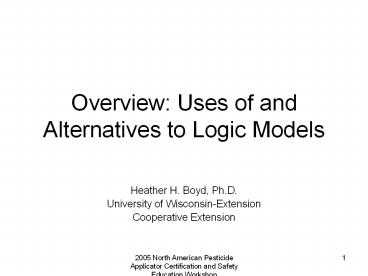Overview: Uses of and Alternatives to Logic Models - PowerPoint PPT Presentation
1 / 15
Title:
Overview: Uses of and Alternatives to Logic Models
Description:
Overview: Uses of and Alternatives to Logic Models Heather H. Boyd, Ph.D. University of Wisconsin-Extension Cooperative Extension Overview Shared understandings for ... – PowerPoint PPT presentation
Number of Views:142
Avg rating:3.0/5.0
Title: Overview: Uses of and Alternatives to Logic Models
1
Overview Uses of and Alternatives to Logic Models
- Heather H. Boyd, Ph.D.
- University of Wisconsin-Extension
- Cooperative Extension
2
Overview
- Shared understandings for todays presentation
- Logic models can be used in evaluation but are
not, in themselves, evaluation - Evaluation is gathering credible information that
describes results associated with your
programming - Program improvement
- Program outcomes and/or impact
3
Logic Models
- Visual display that connects inputs to outputs to
intended results (or a variation of this) - Can be horizontal, vertical, any shape
horizontal and linear is a frequent choice
4
A Basic Logic Model
- INPUTS ? OUTPUTS ? OUTCOMES
5
Description of Parts
- Inputs resources that you use
- Outputs products or activities that you intend
to connect with program participants - Outcomes the results associated with your
programming
6
More detail
- Different people and groups have different
preferences regarding what they include in their
logic model(s) - Can also include situation, priority setting,
external influences, assumptions
7
Applied Example
- INPUTS
- Staff ?
- Funding
- Participant motivation
- OUTPUTS
- Workshops ?
- Technical assistance
- INTENDED OUTCOME
- Improved performance in
- program evaluation
8
Another Logic Model Example
In other words, your logic model can look like
whatever you want it to. Exceptions are when a
logic model template is either expected to be
used or required to be used.
9
Purpose of a Logic Model
- To describe a program and why it works
- To illustrate presumed or intended effects
10
Limitations of Logic Models
- It is only a model, not reality
- Programs are more dynamic than a model can convey
- Might lead one to assume cause and effect when
that assumption could be false
11
Alternatives to Logic Models
- A group conversation
- A brief narrative about the program and its
intended consequences - A set of if-then statements that link your
activities to your intended results
12
Ask Yourself
- Is creating a logic model right for your program
or do you already have the information available
in another format? - Who are the audiences for the logic model? Will
they find the information useful?
13
Ask Yourself
- How can your logic model or group discussion
involve stakeholders in decision-making roles
early on? - Will the group activity of creating a logic model
enhance your programming? If so, how?
14
References
- Taylor-Powell
- www.uwex.edu/ces/pdande/evaluation/evallogicmodel
.html - Schmitz Parsons
- www.insites.org/documents/logmod.htm
- McCawley
- The Logic Model for Program Planning and
Evaluation
15
Resources
- Examples
- http//www.uwex.edu/ces/pdande/
- evaluation/evallogicmodelexamples.html
- In-depth on-line logic model course
- http//www.uwex.edu/ces/lmcourse/






























